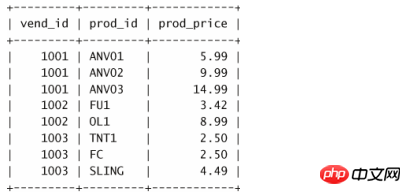As you can see, it is very easy to use. But there are a few rules to be aware of when doing a merge.
1.UNION must be composed of two or more SELECT statements, separated by the keyword UNION (therefore, if 4 SELECT statements are combined, 3 UNION keywords will be used).
2. Each query in a UNION must contain the same columns, expressions, or aggregate functions (although the columns do not need to be listed in the same order).
3. Column data types must be compatible: the types do not have to be exactly the same, but they must be types that the DBMS can convert implicitly (for example, different numeric types or different date types). If these basic rules or restrictions are followed, you can use it for any data retrieval task.
##Include or cancel duplicate rows
We noticed that when executing separately, the first The first SELECT statement returns 4 rows, and the second SELECT statement returns 5 rows. But after combining the two SELECT statements with UNION, only 8 rows were returned instead of 9. UNION automatically removes duplicate rows from the query result set (in other words, it behaves like multiple WHERE clause conditions in a single SELECT statement). Because supplier 1002 also produces an item with a price lower than 5 , both SELECT statements return that row. When using UNION, duplicate rows are automatically suppressed. This is the default behavior of UNION, but it can be changed if desired. In fact, if you want to return all matching rows, use UNION ALL instead of UNION . Please see the following example: Input:select vend_id,prod_id,prod_price from products where prod_price <= 5 union all select vend_id,prod_id,prod_price from products where vend_id in (1001,1002);Output:

select vend_id,prod_id,prod_price from products where prod_price <= 5 union select vend_id,prod_id,prod_price from products where vend_id in (1001,1002) order by vend_id,prod_price;Output:
Analysis: This UNION uses an ORDER BY clause after the last SELECT statement. Although the ORDER BY clause may appear to be an integral part of only the last SELECT statement, MySQL will actually use it to order all results returned by all SELECT statements. 
The above is the detailed content of Example of UNION collation in MySQL combined query. For more information, please follow other related articles on the PHP Chinese website!